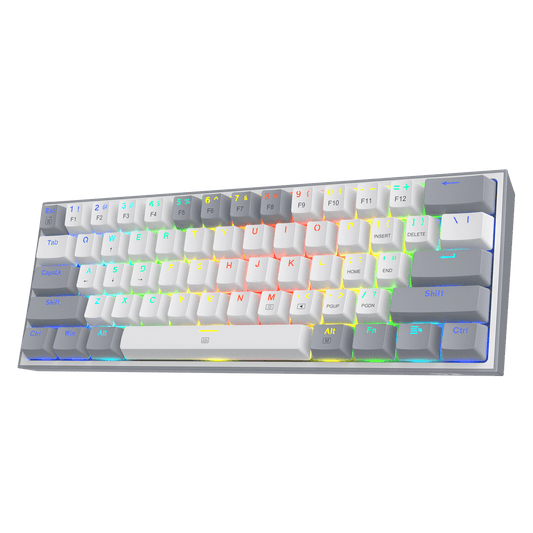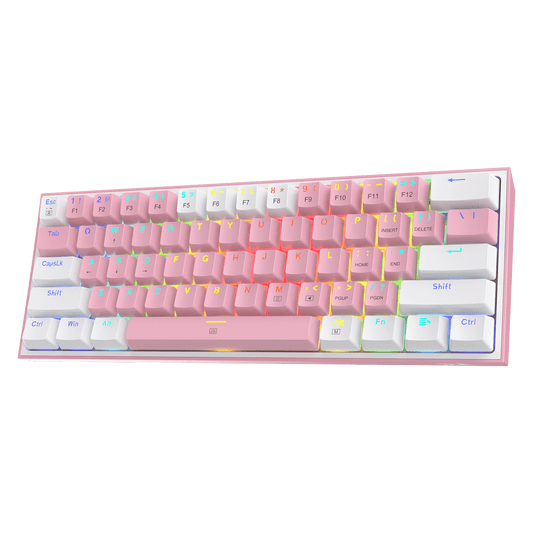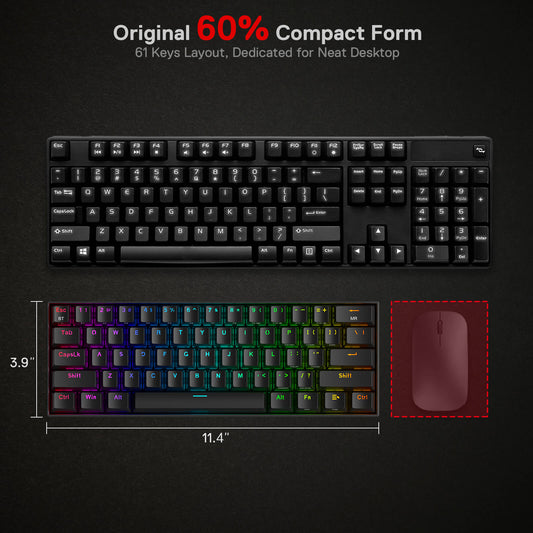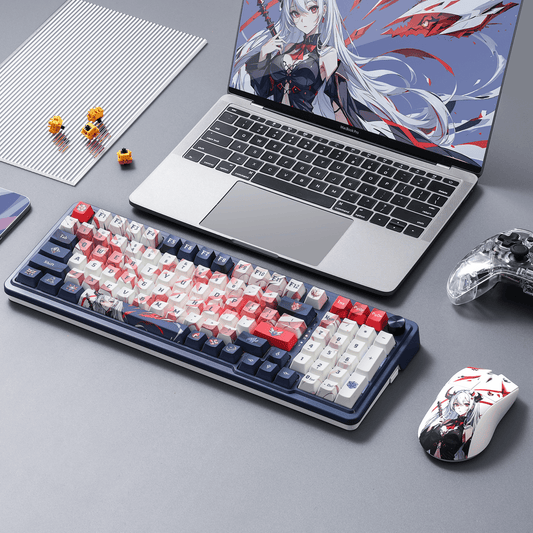Introduction
In the ever-evolving world of technology and personalization, there's a rising trend that's captivating the hearts and fingertips of enthusiasts worldwide: customizing mechanical keyboards. Gone are the days when a keyboard was merely a utilitarian input device. Today, it's a canvas for personal expression, a testament to individuality, and a tool meticulously crafted to elevate the typing experience to new heights. At the heart of this keyboard revolution lies a seemingly simple yet profoundly impactful component: the keycap.

This article explores the exciting phenomenon of customizing mechanical keyboards, delving into the world of keycaps and their profound significance in enhancing the typing experience. From the basics of what keycaps are to the various materials, profiles, and customization options available, we'll take you on a journey through the fascinating realm of keyboard customization. So, whether you're a seasoned keyboard enthusiast or just embarking on this captivating journey, prepare to uncover the art and science of creating the perfect keyboard tailored to your unique style and preferences.
Table of Contents:
WHAT ARE KEYCAPS?
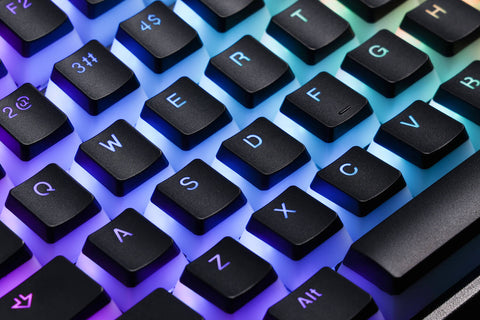
Keycaps are the removable, individual covers that sit atop the switches on a mechanical keyboard. They are the part of the keyboard you press when typing. Keycaps are essential not only for the functionality of a keyboard but also for its aesthetics and customization options. They come in various shapes, profiles, materials, and designs, making them a crucial component for both the typing experience and personalization of your keyboard.
How Do Keycaps Work?

Keycaps work by attaching to the switches on a mechanical keyboard. Each keycap has a stem that fits over the switch's stem. When you press a keycap, it pushes down on the switch's stem, actuating the switch and registering a keystroke. The material, shape, and profile of the keycap influence the feel and sound of typing. Keycaps are also customizable, allowing you to change the look and feel of your keyboard to suit your preferences.
Why Get a New Keycap Set?
There are several reasons why someone might consider getting a new keycap set for their mechanical keyboard:
-
Personalization: Keycaps allow you to personalize the appearance of your keyboard. You can choose keycaps in different colors, designs, and materials to match your style or create a unique look.
-
Enhanced Typing Experience: Changing keycaps can significantly impact your typing experience. Different keycap profiles and materials can make typing more comfortable and enjoyable, whether you prefer a sculpted profile for ergonomics or a smooth, flat surface for speed.
-
Durability and Quality: High-quality keycaps with well-printed legends (letters/symbols) can last longer and maintain their appearance over time. This is especially important if you use your keyboard heavily.
-
Custom Layouts: Some keycap sets offer specialized keycaps for non-standard keyboard layouts or layouts specific to certain software, making it easier to navigate complex applications.
-
Sound and Aesthetics: Keycaps can influence the sound your keyboard makes when typing. Different keycap materials can create a softer, quieter typing sound or a louder, more satisfying click. Aesthetic choices, like keycap color and design, can also enhance the overall look of your keyboard.
How Many Keycaps on a Keyboard?
The number of keycaps on a keyboard depends on the keyboard's layout. Most standard mechanical keyboards have 104 keycaps, including alphanumeric keys, function keys, number pad, navigation keys, and various control keys. However, smaller keyboards, such as 60% or 75% layouts, have fewer keycaps, typically around 61 to 87 keys.
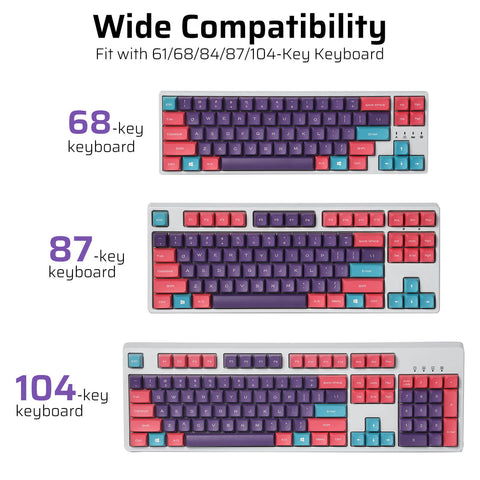
The exact number and arrangement of keycaps can vary based on the keyboard's design and intended use. Specialized keyboards, like gaming keyboards or ergonomic keyboards, may have unique layouts with extra keys or different keycap sizes.
TYPES OF KEYBOARDS THAT USE KEYCAPS
Keycaps are an essential component of various keyboard types, each offering a distinct typing experience. Here are three common types of keyboards that use keycaps:
1. Mechanical Keyboards:
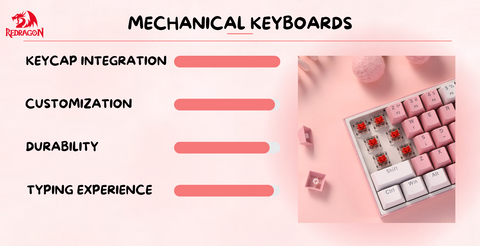
Mechanical keyboards have gained immense popularity among typists and gamers alike for their tactile feedback and durability. These keyboards use individual mechanical switches beneath each keycap, and keycaps are easily removable and replaceable. Mechanical keycaps come in various profiles and materials, allowing enthusiasts to customize their typing experience. The satisfying click-clack sound and distinct key feel of mechanical keyboards make them a favorite among those who appreciate a premium typing experience.
- Membrane Keyboards:
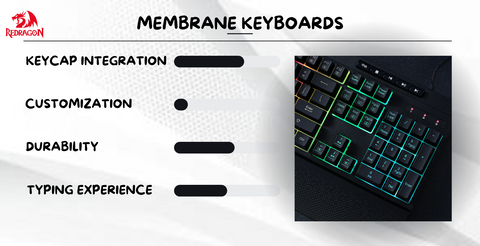
Membrane keyboards are among the most common types of keyboards, often found in laptops and budget-friendly desktop keyboards. They use a rubber or silicone membrane beneath the keycaps to register key presses. While membrane keyboards tend to have lower-profile keycaps, some models still allow for keycap replacement. However, customization options for keycaps in membrane keyboards are more limited compared to mechanical counterparts.
3. Hybrid Keyboards:
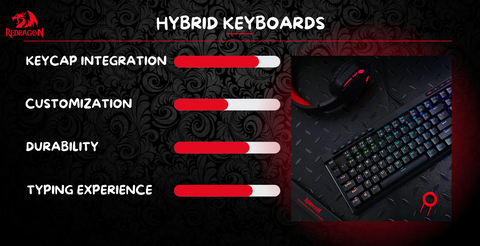
Hybrid keyboards combine elements of both mechanical and membrane keyboards. They feature a membrane layer for most keys, providing a soft and quiet typing experience, while a select few keys, often used for gaming or specific functions, are mechanical for enhanced tactile feedback. Keycap compatibility in hybrid keyboards can vary depending on the design and switch types used.
Keycap Sizes: Finding the Perfect Fit
When it comes to customizing or replacing keycaps on your mechanical keyboard, one of the critical considerations is keycap sizes. Keycaps are not one-size-fits-all; they come in various sizes and profiles to accommodate different keyboard layouts and designs. Let's explore keycap sizes, standardization, and the differences between ANSI and ISO layouts.
Keycaps are not universally standard in size. The size and shape of keycaps can vary depending on the keyboard's layout, manufacturer, and model. However, there are some general standards and common keycap sizes that you'll encounter in the world of mechanical keyboards.
ANSI and ISO Layouts
Two widely recognized keyboard layouts are the ANSI (American National Standards Institute) layout and the ISO (International Organization for Standardization) layout. These layouts have distinct differences in keycap sizing and arrangement:
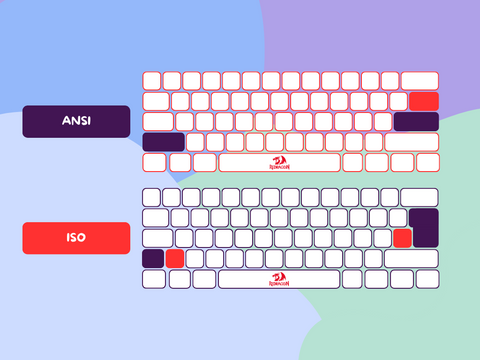
- ANSI Layout:

-
Keycap Sizes: ANSI layouts are common in North America and use keycap sizes that are generally considered standard for most mechanical keyboards. The keycap sizes are consistent, making it relatively easy to find replacement keycap sets.
-
Enter Key: In ANSI layouts, the Enter key is usually rectangular in shape but is sometimes informally referred to as 'L-shaped' due to its position next to the key, which can give it an L-like appearance in the keyboard layout. It occupies two horizontal rows and has a size of approximately 2.25u
-
Left Shift Key: The left Shift key is usually larger than the right Shift key in ANSI layouts, typically around 2.25u or 2.75u.
-
Bottom Row: The bottom row of keys, including the spacebar, Ctrl, Alt, and Windows/Meta keys, often follows a standard size pattern with the spacebar typically being 6.25u or 6.5u wide.
- ISO Layout:
-
Keycap Sizes: ISO layouts are more common in Europe and other regions. They have some differences in keycap sizes compared to ANSI layouts, making it important to choose keycaps that match your specific layout.
-
Enter Key: In ISO layouts, the Enter key is typically taller and narrower, resembling an "L" shape as well. Its size can vary depending on the specific ISO layout (e.g., ISO-UK, ISO-FR).
-
Left Shift Key: The left Shift key is usually smaller than the right Shift key in ISO layouts, typically around 1.25u.
-
Bottom Row: The bottom row keycap sizes can also vary in ISO layouts, with spacebars typically being narrower than in ANSI layouts.
When looking for replacement keycaps or custom keycap sets, it's essential to identify whether your keyboard follows an ANSI or ISO layout to ensure a proper fit. Additionally, some keyboard layouts, such as 60% or 75% keyboards, may have non-standard keycap sizes, so be sure to check the specifications of your specific keyboard model.
What Are Keycap Profiles?

Keycap profiles refer to the specific shape and contour of keycaps on a mechanical keyboard. These profiles determine the height, angle, and overall design of the keycap, which can significantly impact your typing experience. Keycap profiles come in various styles, and each has its unique characteristics. Let's explore some common keycap profiles, including uniform vs. sculpted profiles and popular profiles like OEM, SA, DSA, XDA, and Cherry.
Uniform vs. Sculpted Keycap Profiles
-
Uniform Keycap Profiles: Uniform profiles feature keycaps that are all the same shape and height. These keycaps maintain a consistent level across the entire keyboard, which some users prefer for a flat and uniform typing experience. Uniform profiles like DSA and XDA are popular among enthusiasts for their minimalistic aesthetics and ease of customization.
-
Sculpted Keycap Profiles: Sculpted profiles are designed with varying keycap heights and angles to better accommodate the natural positioning of your fingers. These profiles are sculpted to create an ergonomic feel when typing. Most traditional keycap profiles, like OEM and SA, are sculpted to provide a more comfortable typing experience.
Common Keycap Profiles
-
Cherry Keycaps:
-
Profile: Cherry keycaps, also known as Cherry MX keycaps, are similar in profile to OEM keycaps. They have a slightly curved top surface and are designed for use with Cherry MX switches.
-
Typing Experience: Cherry keycaps offer a familiar and comfortable typing experience, making them compatible with many mechanical keyboards.
-
OEM Keycaps:
-
Profile: The OEM (Original Equipment Manufacturer) profile is one of the most common and widely used keycap profiles. It features a slightly curved top surface and a moderate keycap height.
-
Typing Experience: OEM keycaps provide a comfortable and familiar typing experience, making them a popular choice for stock keyboard keycaps.
-
SA Keycaps (Spherical All):
-
Profile: SA keycaps have a spherical shape, meaning they are curved both horizontally and vertically. They are known for their tall and sculpted design.
-
Typing Experience: SA keycaps offer a unique, retro look and a distinctive, rounded feel while typing. They are favored by some enthusiasts for their aesthetic appeal.
-
XDA Keycaps:
-
Profile: XDA keycaps are uniform and feature a flat, cylindrical top surface, similar to DSA keycaps.
-
Typing Experience: XDA keycaps are known for their sleek, modern aesthetic and comfortable typing experience. They are popular in custom mechanical keyboard builds.
-
DSA Keycaps (Deep Space Cadet):
-
Profile: DSA keycaps are uniform in height and have a flat, cylindrical top surface. They maintain the same shape and height across all keys.
-
Typing Experience: DSA keycaps provide a minimalist and modern appearance. They offer a consistent typing feel, which some users find comfortable for both gaming and typing.
Other Keycaps:
In addition to the keycap profiles mentioned above, there are various specialty and custom keycap profiles designed for specific aesthetics and preferences. These include artisan keycaps, which feature unique and artistic designs, and niche profiles like MT3, KAT, and more.
When selecting keycaps for your mechanical keyboard, consider both the profile and your personal typing preferences. The choice of profile can significantly impact the overall feel and aesthetics of your keyboard, allowing you to tailor your typing experience to your liking.
THE BEST KEYCAP PROFILE FOR GAMING

The choice of the best keycap profile for gaming often depends on personal preferences, but many gamers find that a low-profile keycap profile is well-suited for gaming. The Cherry MX low-profile keycap profile, for example, is popular among gamers for several reasons:
-
Speed and Responsiveness: Low-profile keycaps require less travel distance to actuate, allowing for quicker keypresses, which can be advantageous in fast-paced gaming.
-
Comfort during Long Gaming Sessions: Low-profile keycaps provide a comfortable typing experience during extended gaming sessions, reducing hand fatigue.
-
Enhanced Key Feel: Gamers often appreciate the precise and distinct keypress feel offered by low-profile keycaps.
-
Reduced Key Wobble: Low-profile keycaps tend to have less wobble, which can be beneficial for maintaining accuracy during gaming.
-
Aesthetics: Low-profile keycaps can give a sleek and modern look to gaming keyboards.
THE BEST KEYCAP PROFILE FOR TYPING

When it comes to typing, the best keycap profile is often subjective and depends on individual typing habits and preferences. That said, many typists favor the following keycap profiles for a comfortable typing experience:
-
OEM Profile: The OEM (Original Equipment Manufacturer) keycap profile is a common choice for typing. It features a slightly curved top surface and a standard height, which many people find comfortable for general typing tasks.
-
Cherry Profile: Cherry profile keycaps have a lower height compared to OEM and are appreciated for their comfortable typing experience. They offer a good balance between key travel and typing speed.
-
DSA Profile: DSA (Distributed Structure of Amplitude) keycaps have a uniform height and flat top surface. They provide a consistent feel across all keys, making them popular among typists who appreciate a level surface.
-
XDA Profile: XDA keycaps are similar to DSA but with a slightly wider surface area. They offer a unique typing feel that some users find comfortable.
Keycap Materials

Keycaps come in various materials, each with its own set of characteristics and advantages. The two most common materials used for keycaps are ABS (Acrylonitrile Butadiene Styrene) and PBT (Polybutylene Terephthalate). Let's explore these materials and the key differences between ABS and PBT keycaps:

ABS vs. PBT Keycaps:

KEYCAP THICKNESS
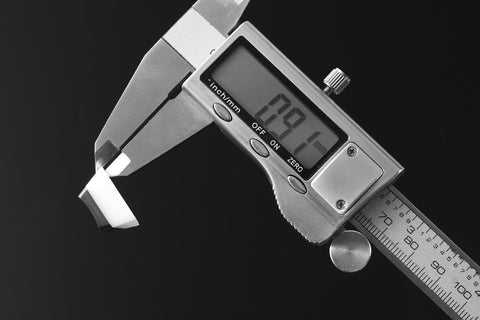
Keycap thickness refers to the measurement of how thick the material used to make the keycap is. It plays a role in the overall feel and sound of typing on a mechanical keyboard. Keycaps come in various thicknesses, which can affect the typing experience in several ways:
-
Thicker Keycaps: Thicker keycaps, often around 1.5mm to 2mm or more, can add weight and stability to the keystrokes. They are less likely to wobble or produce a hollow sound when typing. Thicker keycaps can also feel more substantial and durable.
-
Thin Keycaps: Thinner keycaps, typically around 1mm or less, may feel lighter and produce a different typing sound. They can contribute to a slightly quieter typing experience and may feel less rigid.
The choice of keycap thickness is often a matter of personal preference. Some users prefer the added weight and stability of thicker keycaps, while others enjoy the lighter and quieter feel of thinner keycaps. Keep in mind that keycap thickness can interact with other factors like keycap material and profile to influence the overall typing experience.
THE HEIGHT OF KEYCAPS

The height of keycaps, often referred to as keycap profile, is another crucial aspect of keycap design. Keycap profiles determine the vertical position of each key relative to the keyboard's base. The most common keycap profiles include:
-
OEM Profile: This is the standard keycap profile found on many pre-built mechanical keyboards. It features a medium height and a slightly curved top surface.
-
Cherry Profile: The Cherry profile is similar to the OEM profile but often slightly shorter in height. It's a popular choice among mechanical keyboard enthusiasts.
-
SA Profile: SA (Spherical All) keycaps are known for their tall and sculpted design. They have a distinct spherical shape and are often considered retro.
-
DSA Profile: DSA keycaps have a uniform profile, meaning all keycaps have the same height. They are known for their flat and minimalist appearance.
-
XDA Profile: XDA keycaps are also uniform in height, similar to DSA keycaps. They offer a modern and sleek aesthetic.
-
MT3 Profile: The MT3 profile is known for its tall, sculpted design with a unique concave top surface. It's favored by some enthusiasts for its ergonomic feel.
-
Low-profile: In addition to the traditional keycap profiles mentioned earlier, there are also low-profile keycaps designed specifically for low-profile switches. These keycaps are shorter in height, resulting in a flatter appearance and a sleeker feel on the keyboard. If you're interested in exploring low-profile keyboards and keycaps further, you can check out this blog post for more information on the topic.
HOW ARE KEYCAPS MANUFACTURED?

Keycap manufacturing involves several processes to create the final product. Here's an overview of the key steps:
-
Molding: The process typically starts with molding. Keycaps are formed by injecting molten plastic into molds that have the desired shape and design.
-
Material Selection: Manufacturers choose the keycap material, such as ABS or PBT, based on the desired characteristics of the final product, including texture, durability, and cost.
-
Legend Production: The legends (letters, symbols, or designs) on keycaps can be added using various methods, including doubleshot molding, pad printing, laser engraving, or dye-sublimation.
-
Finishing: Keycaps may undergo additional processes, such as coating or texturing, to achieve the desired look and feel.
Now, let's delve into the various methods for adding legends to keycaps:
Doubleshot Keycaps:
Doubleshot keycaps are made using a two-step molding process. The keycap is first molded with a base layer, usually in one color. Then, a second mold is used to create the legends by injecting a different colored plastic into the depressions. This results in legends that are an integral part of the keycap, making them highly durable and resistant to wear.
Pad-Printed Keycaps:
In pad printing, ink is applied to the keycap's surface using a silicone pad. This method is cost-effective but may result in legends that wear off over time, as the printing is not as durable as other methods.
Laser-Engraved Keycaps:
Laser engraving involves using a laser to etch the legends onto the keycap's surface. It offers precision and longevity, as the engraved legends are less likely to wear off. Laser-engraved keycaps often have a clean and minimalistic appearance.
Dye-Sublimated Keycaps:
Dye sublimation involves printing legends onto a transfer paper and then transferring the ink onto the keycap using heat and pressure. This method provides vibrant and long-lasting legends, as the ink is absorbed into the keycap material.
Pudding Keycaps:
Pudding keycaps are a style of keycap known for their translucent sides. These keycaps are often made from ABS plastic and have a dual-layer design with a translucent top and sides, allowing the RGB backlighting of mechanical keyboards to shine through, creating a visually striking "pudding" effect.
HOW TO CHOOSE THE RIGHT KEYCAP FOR YOU?

Choosing the right keycap comes down to personal preferences and priorities. Here are some factors to consider:
-
Material: Decide between ABS and PBT based on your desired texture, durability, and budget.
-
Legend Type: Consider how important legend durability and aesthetics are to you. Doubleshot and dye-sublimated legends tend to be more durable than pad-printed or laser-engraved ones.
-
Profile: Choose a keycap profile that matches your typing style and comfort preferences.
-
Aesthetics: Select keycaps with colors and designs that you find visually appealing and that match your keyboard's overall look.
-
Budget: Keycap sets can vary widely in price. Decide on a budget that suits your needs and explore options within that range.
-
Compatibility: Ensure that the keycap set you choose is compatible with your keyboard's layout and switch type.
IS YOUR KEYBOARD COMPATIBLE WITH NEW KEYCAPS?

The compatibility of your keyboard with new keycaps depends on several factors:
-
Switch Type: Keycaps must be compatible with the type of switches on your keyboard. Common switch types include Cherry MX, Gateron, Kailh, and more. Ensure that the keycaps you choose are compatible with your switches.
-
Layout: Keyboards come in various layouts, including ANSI, ISO, 60%, 75%, and more. Make sure the keycap set matches your keyboard's layout to ensure a proper fit.
-
Keycap Profile: The keycap profile (e.g., OEM, SA, DSA) affects the keycap shape and height. Ensure that the new keycaps have the same profile as your current ones or one that you prefer.
-
Mounting Style: Some keyboards have non-standard keycap mounting styles. Confirm that the keycaps you want to replace have the appropriate mounting style to fit your keyboard.
-
Bottom Row Compatibility: The bottom row of keys, including the spacebar, Ctrl, Alt, and Windows/Meta keys, can vary in size and layout. Check if the new keycaps include compatible options for your keyboard's bottom row.
Before purchasing new keycaps, review the product details and compatibility information provided by the manufacturer to ensure they will fit your specific keyboard.
ARE CUSTOM KEYCAPS WORTH IT?

Custom keycaps can be worth it if you value personalization, aesthetics, and typing experience. Here are some reasons why custom keycaps might be worth the investment:
-
Personalization: Custom keycaps allow you to tailor your keyboard's appearance to your unique style and preferences.
-
Enhanced Typing Experience: Different keycap materials, profiles, and textures can improve your typing comfort and speed.
-
Quality and Durability: High-quality custom keycaps can be more durable than stock keycaps, with legends that resist wear and fading.
-
Artistic Expression: Some custom keycap sets feature intricate and artistic designs, adding a touch of creativity to your keyboard.
-
Community and Collectibility: The mechanical keyboard community often appreciates and collects unique and limited-edition keycap sets.
Whether custom keycaps are worth it ultimately depends on your priorities and how much you value the aesthetics and typing experience of your keyboard.
HOW TO CLEAN KEYCAPS?
Over time, keycaps can accumulate dirt, grime, and oils from your fingers. Here's how to clean them:

Redragon Keycaps Recommendations
- A130 Pudding Keycaps:

- Pudding keycaps are characterized by their translucent dual-layer design, with the top part being clear and the sides and legends being opaque.
- These keycaps allow RGB backlighting to shine through for a visually appealing look.
- Great for those who want a unique and vibrant appearance for their mechanical keyboard.
- Recommended if you enjoy customizing your keyboard's aesthetics and have RGB lighting.
- Redragon x LTC PBT Double Shot 112-Key Sublimation Keycaps Set (Neon Purple):
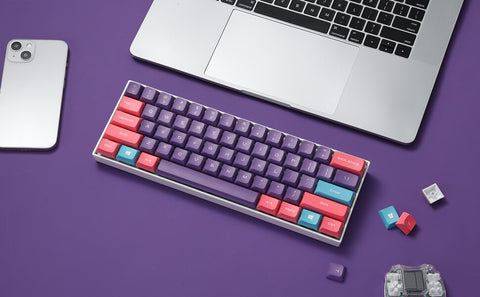
- These keycaps are made of PBT (Polybutylene Terephthalate), known for its durability and resistance to wear and shine.
- Double-shot keycaps ensure legends won't fade over time.
- KDA profile is designed for ANSI layouts, including various keyboard sizes.
- The neon purple color adds a vibrant and eye-catching look to your keyboard.
- Ideal for those who prioritize durability and a unique color scheme.
- Redragon x LTC PBT Double Shot 112-Key Pudding Keycaps Set

- Like the A130 Pudding Keycaps, these keycaps feature a translucent design for RGB backlighting.
- Made from durable PBT material with double-shot legends.
- KDA profile for ANSI layouts, ensuring compatibility with a range of keyboard sizes.
- Comes with a keycap puller for easy installation.
- Suitable for gamers and enthusiasts who want both style and durability.
CONCLUSION
In conclusion, keycaps play a significant role in customizing and enhancing your mechanical keyboard experience. They not only allow for personalization but also impact factors like durability, aesthetics, and typing feel.
Here are answers to some common questions and considerations regarding keycaps:
Q&A:
-
Will I need anything else to change my keycaps?
Generally, you'll only need a keycap puller, which is often included with keycap sets, to remove and replace keycaps. Ensure the keycap set you choose is compatible with your keyboard.
-
Is it worth paying extra for high-end keycaps and name brands?
High-end keycaps and name brands often offer better build quality, durability, and unique designs. Whether it's worth the extra cost depends on your preferences and priorities.
-
Will Keycaps Fit Any Keyboard?
Keycap compatibility depends on factors like keycap profile, layout, and switch type. Ensure you choose keycaps that match your keyboard's specifications.
-
Do keycaps make a difference?
Yes, keycaps can significantly impact your typing experience, aesthetics, and even sound. Different materials and profiles provide unique feels and looks.
-
Why are keycap sets so expensive?
Keycap sets can be expensive due to the quality of materials, manufacturing processes, and custom designs. High-end keycaps often offer better durability and aesthetics.
-
Do all keycaps fit all keyboards?
No, keycaps are not one-size-fits-all. Compatibility varies based on factors like layout, switch type, and keycap profile. It's essential to choose keycaps that match your keyboard.
-
Are there keycaps for different switch types?
Yes, keycaps are often compatible with various switch types, such as Cherry MX, Gateron, and more. Ensure the keycaps you choose match your keyboard's switches.
-
ABS vs. PBT, Which is Better?
The choice between ABS and PBT keycaps depends on your priorities. PBT keycaps are known for durability, while ABS keycaps are often more affordable. Consider your preferences for key feel and longevity when deciding.









































